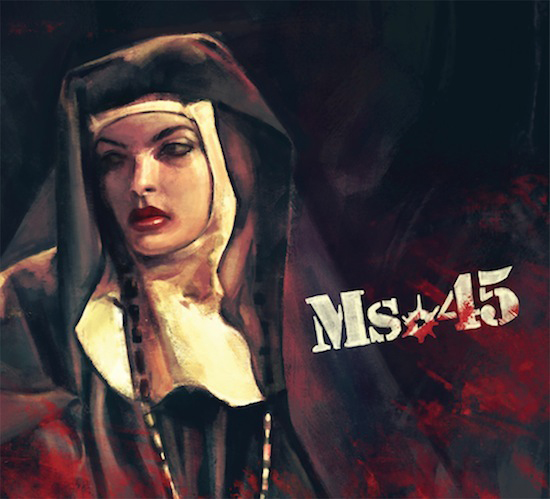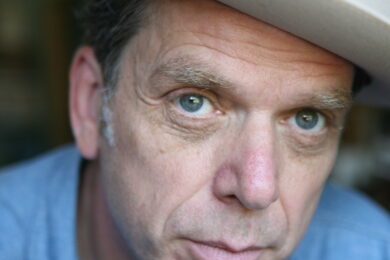After Joe Delia’s teenage band The Bruthers signed to RCA in 1966 he became an in-demand gun for hire, playing live back up to Stevie Wonder, Chuck Berry and The Isley Brothers. Then in the 1970s he progressed on to studio session work and production in New York for the likes of Dusty Springfield, Pat Benatar and The Left Banke. His first notable bit of TV work was giving voice to various muppets during their debut appearance on The Ed Sullivan Show (sadly the identity of which characters has not been preserved for posterity). And from that watershed moment it was only a hop, skip and a jump to him becoming Abel Ferrara’s most trusted soundtrack writer of the 1980s.
Delia worked on the maverick director’s arty, controversial full-length debut The Driller Killer in 1979 but nearly missed out on the more critically acclaimed follow up Ms. 45 in 1981. As Delia reveals in the sleeve notes that come with this typically beautiful Death Waltz release, it was a close run thing: "Closing the deal with Abel had reached an impasse. I sat across from him at a cigarette-scarred coffee table fashioned from a large cable spool at the lower Manhattan loft headquarters for Ferrara’s Films. On two earlier projects, it was the same little ritual – he scribbled a number on a scrap of paper and pushed it across to me. At the time, I was creating the arrangements for disco records and playing piano for some of the best singers on the planet. I shook my head and said, ‘I’ll have to think about it.’"
His brother Frank Delia, one of Ferrara’s cameramen talked him round, saying the offer was a once-in-a-lifetime type deal and that he should do it no matter how desultory the reimbursement. When the composer got back to the director’s HQ he found that his space had already been filled by a session musician. But Joe Delia appealed to the director’s perverse sense of humour by stating that the musician could be kept on to fetch the pair coffee when they needed it and the job was his again.
Ms. 45 was a markedly different film from the director’s feature length debut. The Driller Killer set out to mess with the viewer’s expectations, especially given the title and genre of the film. The follow up was, ostensibly a straight up rape-revenge/vigilante exploitation movie however. The narrative concerns Thana (played by the the excellent Zoë Lund), a mute garment factory worker, who is raped twice in one day by different assailants. She kills the second attacker and cuts the body up before eventually disposing of the pieces all over New York. As the conventions of these films demand, Thana is reborn as an avenger… but it is how she is reborn that causes some (or is that actually most) viewers consternation; she transforms into a stockings and suspenders wearing, highly sexualised nun who then goes round NYC blowing creepy men away with her titular .45. Where the film departs from the standard narrative is her choice of victims. She doesn’t target her attacker still at large, not knowing who he is, but starts with bad sorts and ends up just killing men indiscriminately. There is a feminist reading of the film available should you want to look for it as well as commentary on the dog eat dog world of New York in the early 80s and perhaps even a skewering of the exploitative fashion industry. Certainly Ferrara is clever enough to ensure that Ms. 45 works as a meta commentary on the revenge thriller genre itself. He is however primarily a provocateur and if his aim was to make everyone bar the most sadistically-minded viewer very uncomfortable then he succeeded.
In terms of graphic content Ms. 45 is certainly by no means the worst offender of its day when it comes to portraying violent sexual assault on women. But this leads us directly to another problem – it was such a common theme in cinema in this period that Ms. 45 – no matter how you choose to interpret it as an individual film – can’t help but be a small stitch in a much larger more depressing tapestry. Despite the 70s and early 80s being something of a golden era for strong female actors/roles in Hollywood, I would suggest the only general reading you can take from the New Hollywood period in total is a fairly grim one when it comes to how women are portrayed by the movie industry. These films inadvertently held a mirror up to a culture that generally did not value the happiness and safety of women. (One could say, ‘How times have changed!’ But it’s entirely possible that the times they are a changing back again. A friend reporting from a UK horror movie festival last year said to me: "I thought I was supposed to be attending London Fright Fest not London Rape Fest. And for some it’s business as usual. July sees the release of Abel Ferrara’s latest movie, Welcome To New York which hinges on the attempted rape of a hotel maid by a morally blank French financial diplomat.)
It is undeniable that Ferrara was a great diarist of the old, unreconstructed pre-Zero Tolerance, post-lapserian New York; a documenter of the sleaze, the drugs, the streets, the fashion, the depravity and the violence. And in Joe Delia he found a great sonic foil. In Ms. 45 the pre-transformation Thana is represented by stark, atonal, contrapuntal 12 tone piano sketches beefed up with Mini-Moog synth drones and ARP synthetic strings. Post-transformation the album switches track completely however.
Delia (who was on keys) drafted in Sonny Sharrock drummer Abe Speller, rated saxophonist Artie Kaplan and one time Ornette Coleman bassist Don Payne to form his band. And while the vibe they were going for was clearly jazz fusion the urgency of the sessions, the scabrous presence of Ferrara and the hellish vibe of late night New York impinged on proceedings giving everything more of a no wave/post punk sense of grit and chaos. ‘First Attack’ has a fabulously off-kilter choppy rhythm guitar that is reminiscent of Gang Of Four’s ‘At Home He’s A Tourist’. There is some utterly depraved funk bass soloing on ‘Bass And Drums Thana Walking’ and there’s a hint of James Chance to ‘Thana In The Mirror V2’.
Joe Delia – Ms. 45 Original Motion Picture Soundtrack – released officially for the first time this year gets the kind of pressing it deserves in an age when a lot of labels are churning out rarities as cheaply as humanly possible at an insane rate because they fear the game is up. Death Waltz do the exact opposite but this is what we’ve come to expect from them. And this record doesn’t disappoint: thick card packaging that you could build an Anderson Shelter out of, amazing new art work of Thana in a habit wielding a gun by Alice X. Zhang spread across the outside of a gatefold and suitably nun-coloured black and white vinyl. (Extras include a fold out poster and sleeve notes by Delia himself.)
Legendary B-movie producer and director Roger Corman had a well rehearsed method for raising money for film projects by the 80s. He would name a film, come up with a stunt poster and then start raising capital by pre-selling it to different worldwide territories, knowing full well that the finished result might not bear any similarity to what he’d originally pitched. And so it was with the proposed film Forbidden World, whose original poster depicts a monstrous demon winged mutant mantis towering over a woman in her smalls manacled to a rock. By the time the film was actually released it was called Mutant and featured a monster that looked more like a black rubber dildo with teeth. Allan Holzman, who directed and edited the film as well as producing and editing the soundtrack, freely admits that it was written in two days and shot in thirty. In fact, even Death Waltz boss Spencer Hickman gleefully admits that Mutant was an "Alien rip-off but made for about 50p". But in this instance it’s purely the music that we’re interested in.
Susan Justin – Forbidden World is another worthy addition to the label’s catalogue and comes in the newly designed cardboard sleeve which allows you to get all your booty in and out of the packaging without having to use pliers. (In this case the booty is a fold out poster of the ultra fine 0.01 Copic marker pen drawn, gore suggesting artwork by Kimberley Holladay, sleevenotes by the artist and Holzman and a slab of satisfyingly deep-hued splatter vinyl.) As with a lot of B-movie soundtracks, the masters have long since been lost and this record was mastered from a cassette owned by Justin herself: there’s a little surface noise but the overall sound quality is surprisingly good.
Justin – who was dating Holzman during this period – was in a new wave synth punk band called Pink Plastic; something that definitely influenced this, her debut OST. It is an enjoyably dynamic soundtrack which ranges from abstract synthesizer soundscaping, to John Carpenter-esque Moog funk via brash and bombastic Walter Carlos-like fanfares. While the pop elements to the album (‘Theme From Forbidden World’, ‘Mutation’) are what hook you initially, there is undeniably some out there experimentation going on at the same time. One of the musicians on the album who helped to realise Justin’s vision was Craig Huxley, a former child actor on the original Star Trek TV series. As well as playing the Jupiter 8 synth he contributed a performance on an instrument of his own design, the Blaster Beam: a 16 foot high aluminium harp strung with bronze wire.
Perhaps lower down the power tool themed B-movie pecking order than The Driller Killer is Amy Jones’ The Slumber Party Massacre but no less interesting is its OST. All of the music for the film was produced with a Casiotone MT-30, crystal glasses and cymbals: three basic elements which are used to startling effect. This particular synthesizer was a relatively popular, high street store model out at the start of the 80s and one of the first of Casio’s products to feature polyphony. It used so-called vowel consonant synthesis to mimic other instruments – often quite poorly. The sounds that you could get out of it were often similar to the tones you’d hear on home computers such as the Commodore 64 or the Atari XL and bore little resemblance to the instruments they were named after. So it’s quite surprising that such a relatively sophisticated soundtrack, full of sepulchral drones, sinister arpeggios and harshly synthesized stabs, was recorded using it to be honest.
As for the film, well, imagine what you think happens in a film called The Slumber Party Massacre and I assure you, you won’t be far off the mark. It’s not Last Year At Marienbad. And of course that’s the point of these fetishised soundtrack oddities; it doesn’t matter how trashy, unmemorable, preposterous or awesome these half-forgotten films are; there are always going to be a number of OSTs where the newly available technology of the day, freedom from directorial interference and the struggle against time, equipment and budget related restrictions have conspired to produce genuinely ear-boggling music that’s worth seeking out.




